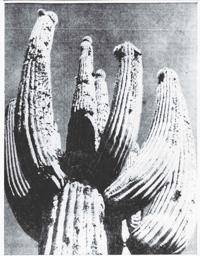What happens to a Saguaro that has been subjected to a severe freeze?
Our giant symbols of the desert are fairly hardy and most of them are able to heal with a few scars.
From the Arizona Daily Star, Tuesday, March 26, 1968:
White Tissue Left
Saguaro Scarred By 1961 Frost
By PETE COWGILL
Hundreds of Saguaro cacti in the Santa Catalina Mountains are now bearing spectacular white scars as a result of a near-killing freeze seven years ago.
The scar tissue on the Saguaros is mainly on the southeast-facing side of the trunks or arms and it occurs in isolated stands in the area where the Santa Catalina Why. leaves the flat plain and begins to climb up toward Molina Basin.
The white scars are particularly noticeable in the early morning hours when the sunlight is reflected directly from the surface of the plants.
When the low temperatures occurred in January, 1961, the upper parts of the limbs and the trunks of the Saguaros were gradually frozen. But a sudden thaw coupled with several hours of direct sunlight caused a rapid rise in temperature on the surface of the plants which resulted in — at the time — decomposition of the surface tissue and in many instances, an emission of a blackish fluid.
Over the years, the surface tissue healed and sealed the plant from further damage. The result is the longish white scar seen on many Saguaros. These plants have continued to grow and were not appreciably affected by the freeze, except for the scar tissue.
Similarly scarred Saguaros can be seen in the Tucson Mountains and in many other areas of southern Arizona where freezing and rapidly thawing conditions have occurred recently.
We should all be so fortunate.





